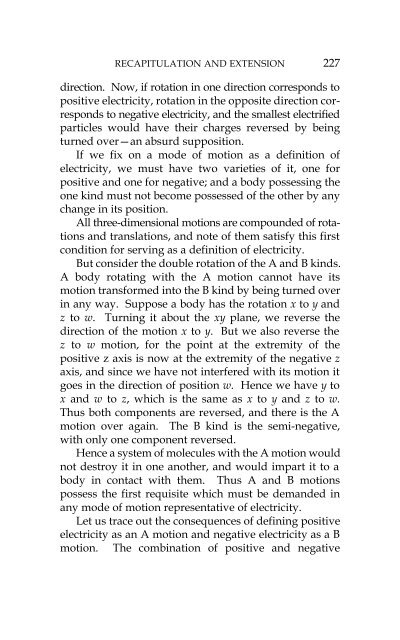Create successful ePaper yourself
Turn your PDF publications into a flip-book with our unique Google optimized e-Paper software.
RECAPITULATION AND EXTENSION 227<br />
direction. Now, if rotation in one direction corresponds to<br />
positive electricity, rotation in the opposite direction corresponds<br />
to negative electricity, and the smallest electrified<br />
particles would have their charges reversed by being<br />
turned over—an absurd supposition.<br />
If we fix on a mode of motion as a definition of<br />
electricity, we must have two varieties of it, one for<br />
positive and one for negative; and a body possessing the<br />
one kind must not become possessed of the other by any<br />
change in its position.<br />
All three-dimensional motions are compounded of rotations<br />
and translations, and note of them satisfy this first<br />
condition for serving as a definition of electricity.<br />
But consider the double rotation of the A and B kinds.<br />
A body rotating with the A motion cannot have its<br />
motion transformed into the B kind by being turned over<br />
in any way. Suppose a body has the rotation x to y and<br />
z to w. Turning it about the xy plane, we reverse the<br />
direction of the motion x to y. But we also reverse the<br />
z to w motion, for the point at the extremity of the<br />
positive z axis is now at the extremity of the negative z<br />
axis, and since we have not interfered with its motion it<br />
goes in the direction of position w. Hence we have y to<br />
x and w to z, which is the same as x to y and z to w.<br />
Thus both components are reversed, and there is the A<br />
motion over again. <strong>The</strong> B kind is the semi-negative,<br />
with only one component reversed.<br />
Hence a system of molecules with the A motion would<br />
not destroy it in one another, and would impart it to a<br />
body in contact with them. Thus A and B motions<br />
possess the first requisite which must be demanded in<br />
any mode of motion representative of electricity.<br />
Let us trace out the consequences of defining positive<br />
electricity as an A motion and negative electricity as a B<br />
motion. <strong>The</strong> combination of positive and negative






![[PDF] Prolegomena](https://img.yumpu.com/16774951/1/190x245/pdf-prolegomena.jpg?quality=85)









